





Washington D.C.'s National Cherry Blossom Festival attracts over one million visitors annually. Although festival goers can find plenty of activities, the real attraction is a natural party of sorts -- thousands of cherry trees putting forth their magnificent pink and white springtime display. The year 2012 marks the 100th anniversary of a floral show celebrating an enduring international friendship.
A Gift From Japan
The capital's first Japanese cherry trees arrived in the early years of the 20th century as a gift from Tokyo mayor Yukio Ozaki in recognition of the relationship between Japan and the U.S. The Japanese have for centuries revered blossoming cherry trees, or sakura. During the spring blooming period, called hanami, many Japanese make special trips to view cherry trees from a distance, especially in combination with nearby shrines or temples. Holding a picnic beneath cherry trees is another highly popular activity, allowing viewers to revel in the beauty directly overhead. Cherry blossom festivals take place throughout Japan in the springtime.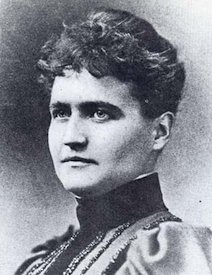 Eliza Scidmore's Dream
Eliza Scidmore's Dream
The impetus for Washington’s now world-famous spring festival came from one woman who, despite years of discouragement, never abandoned her dream of bringing a bit of Japan to America. Eliza Ruhamah Scidmore (pronouned Sidmore), born in 1856, was a journalist, photographer and inveterate traveler who would eventually gain distinction as the first woman to serve on the board of the National Geographic Society. Upon her return from the first of many trips to Japan, Scidmore in 1885 was seized with the idea of planting Japanese cherry trees in her home town of Washington D.C. She had been captivated by the beauty of Japan’s cherry blossoms and envisioned such trees beautifying the swampy Tidal Basin area of the capital.
Scidmore’s detailed plans, accompanied by her photographs of Japan’s trees, did little to sway officials. Washington park superintendents repeatedly rejected her proposals. But Scidmore’s persistence eventually paid off in 1909, 24 years after her initial vision. With help from botanist David Fairchild and new First Lady Helen Taft, the cherry tree beautification project finally gained momentum. After learning of the plan, the city of Tokyo offered to provide an additional 2,000 trees. Upon inspection by the Department of Agriculture, the original 1910 shipment of trees from Japan was discovered to be infested with agricultural pests and disease. President Taft ordered them burned, lest they infect domestic trees. Japanese officials responded by sending another 3,020 trees of 12 different cultivars, whose lineage included some of Japan's finest stock.
Washington’s Cherry Trees
In a quiet ceremony on March 27, 1912, Mrs. Taft and Viscountess Chinda, wife of the Japanese ambassador, planted the first two of the now historic trees on the north bank of the Tidal 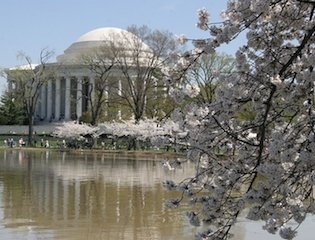 Basin. (These two original trees, marked with a bronze plaque, remain standing a few hundred yards west of the John Paul Jones Memorial at the terminus of 17th Street, SW.) The planting was commemorated by school children in 1927, but it was not until 1935 when civic groups first organized a “Cherry Blossom Festival.”
Basin. (These two original trees, marked with a bronze plaque, remain standing a few hundred yards west of the John Paul Jones Memorial at the terminus of 17th Street, SW.) The planting was commemorated by school children in 1927, but it was not until 1935 when civic groups first organized a “Cherry Blossom Festival.”
With emotions running high in wartime, the festival was temporarily suspended during World War II, but resumed in 1947. The cherry trees along the Arakawa River near Tokyo, source of the parent stock for Washington’s trees, fell into decline because of the war. In 1952, the U.S. National Park Service responded to Japan’s request for assistance by sending budwood to help restore the famed grove. More recently, in 1997 the U.S. National Arboretum assisted in taking cuttings from those cherry trees documented as being among the original 1912 shipment, to ensure the maintenance of their particular genetic line. In 2011, the National Park Service presented the Japan Cherry Blossom Association with 120 trees propagated from the 1912 survivors, helping to guarantee the survival of this especially beautiful strain.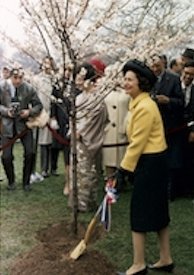 The capital's floral display became significantly more impressive in 1965, when First Lady Ladybird Johnson accepted another generous gift from the Japanese -- 3,800 more trees, this time American-grown. Mrs. Johnson, well known for her dedication to the beautification of America, reenacted the planting ceremony of 1912 with Mrs. Ryuji Takeuchi, wife of the Japanese ambassador. Many of these trees now enhance the grounds of the Washington Monument.
The capital's floral display became significantly more impressive in 1965, when First Lady Ladybird Johnson accepted another generous gift from the Japanese -- 3,800 more trees, this time American-grown. Mrs. Johnson, well known for her dedication to the beautification of America, reenacted the planting ceremony of 1912 with Mrs. Ryuji Takeuchi, wife of the Japanese ambassador. Many of these trees now enhance the grounds of the Washington Monument.
Cherry Tree Varieties
Of the 12 varieties of cherry originally planted, two types now predominate -- Yoshino and Kwanzan. Yoshino, the type encircling the capital’s Tidal Basin, produce many single white blossoms. Mingled among the Yoshino cherries and blooming at the same time are Akebono cherry trees, a mutation of the Yoshino, which bear single blossoms of pale pink.
The Kwanzan variety, one of the showiest of the cherries, produces long-lasting large pink double flowers that open two weeks later than that of the Yoshino. You can see these trees in the East Potomac Park along with cultivars Fugenzo, with double rosy-pink blossoms, and Shirofugen, with double white flowers that age to pink.
Interspersed among these varieties is the lovely weeping Japanese cherry tree or Higan cherry tree. Blossoms of the weeping type vary in color from white to dark pink and may be single or double. The weeping Japanese cherry blooms about one week prior to the Yoshino. Other varieties featured in Washington are the autumn flowering cherry tree, with semi-double pink blooms; the Sargent cherry, with single dark pink flowers; and the Usuzumi cherry, which bears whitish-gray flowers.
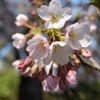
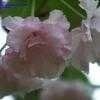
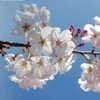
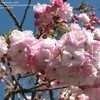
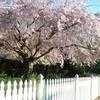 Yoshimo cherry
Yoshimo cherry
Kwanzan cherry
Akebono cherry
Shirofugen cherry
weeping cherry
Festival Events and Blossom Viewing
America’s National Cherry Blossom Festival is officially opened by the lighting of a 2-ton, 8-foot-high granite Japanese lantern. The lantern was presented by the Japanese ambassador to the City of Washington in 1954, in commemoration of the first peace treaty between the U.S. and Japan, signed by Commodore Mathew Perry in 1854. The two-week-long festival begins on the last Saturday of March. Festival activities include a kite festival, a sushi and saki celebration, art exhibits, cultural performances, a parade and fireworks.
The average date of the cherry trees’ peak bloom in Washington, D.C. is April 4, but unusually warm, cool or rainy springs can alter the date by as much as two weeks. The National Park Service offers an up-to-date bloom schedule.
Resources
National Cherry Blossom Festival
National Park Service: Cherry Blossom Festival
ElizaScidmore.com
Images:
Thumbnail of cherry trees and Washington Monument from Wikimedia, in the public domain
Blossoms and Jefferson Memorial from Wikimedia from the Al Jazeera Creative Commons Repository
Eliza Scidmore from Wikimedia Commons in the public domain
Ladybird Johnson from Wikimedia Commons in the public domain
DG Member Photos:
Yoshino cherry and akebono cherry by growin
Kwanzan cherry by hczone6
Shirofugen cherry by GardenGuyKing
Weeping cherry by bootandall
(Editor's Note: This article was originally published on April 3, 2012. Your comments are welcome, but please be aware that authors of previously published articles may not be able to respond to your questions.)
Copyright © www.100flowers.win Botanic Garden All Rights Reserved